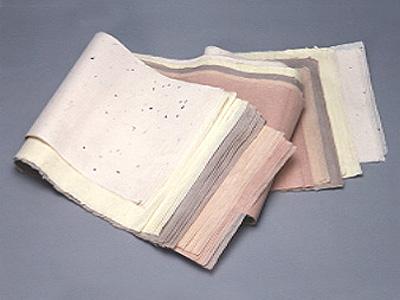|
Yoshino handmade Japanese paper (washi) is a traditional handicraft, and representative of Nara. It is sometimes called uda paper, misu paper or kuzu paper, and is known for its outstanding texture and strength. It is also designated as a traditional handicraft of Nara.
The history of washi dates back more than 1300 years and is said to have been begun by Oamano-oji (later Emperor Temmu) who taught the village people of Kuzu the art of papermaking. Oamano-oji is also known for gathering an army and fighting at Yoshino during the Jinshin rebellion in 672.
Yoshino paper began to spread nationwide in the Edo period. The paper was named uda paper because merchants from Daiwa Uda-cho sold it throughout Japan, and it was found useful for mounting or backing paper or fabric.
The handmade paper of Yoshino is very thin, yet sturdy. There are currently 12 families who still protect the tradition and techniques of papermaking here, and who make an important contribution to the making of paper for shodo sliding doors and for repairing national treasures.
The history of washi dates back more than 1300 years and is said to have been begun by Oamano-oji (later Emperor Temmu) who taught the village people of Kuzu the art of papermaking. Oamano-oji is also known for gathering an army and fighting at Yoshino during the Jinshin rebellion in 672.
Yoshino paper began to spread nationwide in the Edo period. The paper was named uda paper because merchants from Daiwa Uda-cho sold it throughout Japan, and it was found useful for mounting or backing paper or fabric.
The handmade paper of Yoshino is very thin, yet sturdy. There are currently 12 families who still protect the tradition and techniques of papermaking here, and who make an important contribution to the making of paper for shodo sliding doors and for repairing national treasures.
| [+ADDRESS] | 
|














